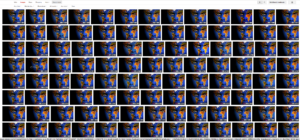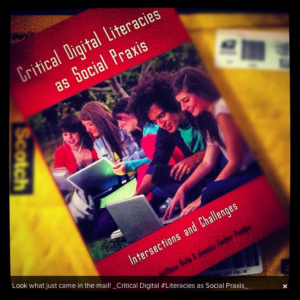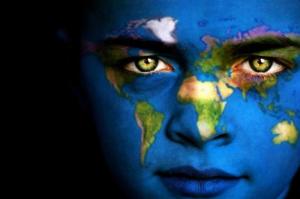How can I hear my own voice unless it bounces off of yours?
I have had that single line in my mind for years. It isn’t particularly poetic, and I don’t completely agree with what it implies, but I’ve tried relentlessly to write the poem I hear inside it. It has something to do with the way the masses in NYC weave, avoid, embrace. I wrote another line once trying to get near it:
As a child I would drag my fingers through water or hold my arm out car windows to feel this–this particle rumba, this caressing, this giving and taking of space.
I thought of the line and concept again as I was flipping through photographs students in the EXCEL Academy @ NYU had saved while doing some digital writing of their own. I found this photograph, and I paused. I thought of the conversations we have had this week on #digiwrimo about the changing nature of audience — potential, imagined, intended, unknown, collateral — when our writing occurs in networked digital spaces. I wondered: If the world is my potential (imagined, intended, unknown, collateral) audience, is my looking glass self, is who I am in relation to who I think you are, what is the voice I hear when I write here and like this?
@Jessifer Agreed. With my students I refer to this as “the new rhetoric.” A constant, rather than merely selected audience. #digiwrimo
— Chuck Rybak (@ChuckRybak) November 21, 2012
 Unsurprisingly, when I looked up the photograph to find who I could attribute it to, I found four pages of “similar images” used in websites all over — without attribution. I thought of replication in the “particle rumba” I hear in voices, the constant “giving and taking of space.” I wondered: When your message, your media, your words can be and are so often available to be appropriated and remixed, what are we able to hear and voice that outside of a digital, networked space are unavailable? What voices do we hear when we are collapsed into audience — viewing our messages and media spin and weave — as we write, replicate to distribute, and write again in response, and in response to response? When we see our digital messages a month, a year, a few years later returned to us, can we recognize the voice as it was above the din of all that we can now hear?
Unsurprisingly, when I looked up the photograph to find who I could attribute it to, I found four pages of “similar images” used in websites all over — without attribution. I thought of replication in the “particle rumba” I hear in voices, the constant “giving and taking of space.” I wondered: When your message, your media, your words can be and are so often available to be appropriated and remixed, what are we able to hear and voice that outside of a digital, networked space are unavailable? What voices do we hear when we are collapsed into audience — viewing our messages and media spin and weave — as we write, replicate to distribute, and write again in response, and in response to response? When we see our digital messages a month, a year, a few years later returned to us, can we recognize the voice as it was above the din of all that we can now hear?
#nowdigi Digital writing is a dance.
— Timothy Merritt (@timothymerritt) November 18, 2012
 Just this week, I came home to find a special prize in my mailbox. It was my copy of Critical Digital Literacies as Social Praxis: Intersections and Challenges
Just this week, I came home to find a special prize in my mailbox. It was my copy of Critical Digital Literacies as Social Praxis: Intersections and Challenges, an edited volume in which I have a chapter with Glynda Hull. In it we detail the digital writing processes of Tyson, a high school student in the South Bronx, as he layered text, photographs, visual transitions, quotes, music, and eventually a film clip made by a young woman in India, Bakhti, whose work he had gained access to through a closed, international social network. Through this composing process, Tyson reframed the message he was intending to express, and this was no small shift: from “wanting lots of money” to the importance of exploring the concept of struggle through historical, global, and caregiving lenses. Tyson’s voice was accented by images, textured with quoted passages from a book, and (re)tuned to (and by) Bakhti’s voice–all through appropriation of other voices and their messages.
I’ve come to realize that we don’t have to be typing simultaneously in a GDoc to have your voice in mine. In contemporary composition, in digital writing, you are my collaborator when I sit to write. I hear @slamteacher‘s poetic strains and @jessifer‘s short, snappy refrains. I hear what @elemveee is reading and how @maryannreilly is seeing. I hear these in my voice, and your voices give my messages texture.
How very exciting that the last day of this month does not mean the end to our digital writing! For many of this month’s participants, I’ve just begun to hear you. (And let’s be honest, the first I heard from you was probably a #TvsZ zombie groan.) I can’t wait to hear more. I can’t wait to dance the particle rumba, to collaborate from a distance, to hear my voice in yours and yours in mine.
#Digiwrimo has introduced me to a wealth of wonderful, clever, insanely smart people on Twitter. I don't want it to end.
— Heather McLendon (@hemclendon) November 22, 2012


